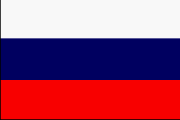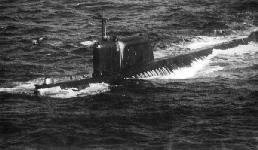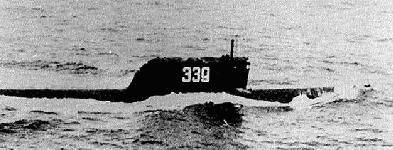





Development of the 658 Hotel Class nuclear powered ballistic missile submarine, to be equipped with the D-2 launch system and R-13 missiles, was approved on 26 August 1956. Work on the design documentation began in September 1956, and the technical project was completed in the first quarter of 1957. However this preliminary design was not developed because it would have taken too long to complete. The duties of the chief designer of the project 658 were originally assigned to the chief engineer of OKB-18 P. Z. Golosovskogo. In February 1958 the project management was transferred to I.V. Mihaylov, who in October 1958 had replaced S.N. Kovalev. The deputy of the chief designer was from outset I.D. Spasskiy.
The Hotel I submarine was a modification of the first Soviet atomic submarine of the 627 November class. Unlike the November it was equipped with a missile compartment that had previously been used on the Golf submarines. Additionally, small horizontal hydroplanes were added to provide better maneuverability. For high-speed underwater operations with reduced noise, more reliable electrohydraulic-command control surfaces were implemented using main ballast low pressure air.
The Hotel I carried three R-13 missiles and the D-2 launch system placed in vertical containers directly behind the sail. All three missiles could be fired within 12 minutes after the submarine surface.
The first Hotel submarine -- "K-19" -- was laid down on 17 October 1958. The construction of the boats was completed on 12 November 1960 when the last of eight Hotel submarines was launched. All of them were built at the shipyard in Severodvinsk.
In March 1958 it was decided to modify the Hotel I design to accommodate the D-4 launch system which could conduct submerged missile launches. This modified SSBN received the designation 658M Hotel II, and the chief designer of the Hotel II was S.N. Kovalev. The installation of the D-4 launching system required some structural changes of the submarine. Before launch water filled the gap between the launch tube and the missile. To fire the missiles the submarine had to come to a depth of 16m.
The upgrading of an advanced submarine under the project 658M was completed on December 30, 1963. Between 1963 and 1967 all Hotel I submarines but one ("K-145") were re-equipped with the D-4 launch system.
From 1969 to 1970 the "K-145" submarine was re-equipped to test the R-29 missiles converted. It received the designation 701 (Hotel III). Its length increased up to 130 m and the displacement increased to 5500 Tons surfaced and 6400 Tons submerged. The maximum speed was reduced up to 18 knots on the surface and 22 knots submerged. Four launching racks for R-29 missiles were placed in a compartment. In 1976 the "K-145" Hotel III was introduced into the Navy.
The two Hotel I submarines that were launched in 1960 were sent to the Western Theater and formed a brigade together with 627A submarines. From this brigade in January 1961 a flotilla consisting of two divisions was organized which included all the Project 658 missile-submarines . In March 1964 the division was transferred to Gadzhiyevo base as part of the 12th squadron, which subsequently became the Northern Fleet 3rd Flotilla. By the late 1960s the division began to fill with new 667A Yankee I submarines, and in late 1970 one Hotel II submarine was transferred to the 18th division at Gremihu. The Hotel submarines of the Northern fleet were removed from operational status during 1986-1991.
Two 658 Hotel I submarines ("K-178" and "K-55") were transferred to the Pacific Fleet in September 1963 and 1968 and served in the 45-th division of atomic submarines on Kamchatka. Both submarines were subsequently converted into the Hotel II class. They were decommissioned in 1988 and 1990.
A series of serious emergencies occurred on board Hotel I "K-19". In February 1961 a depressurization in the first containment of the reactor occurred. The next accident happened in the summer of 1961 while the "K-19" was on its first patrol mission during a naval exercise in the Atlantic Ocean close to Southern Greenland. On 04 July 1961 the patrolling submarine's port side pumps ensuring circulation of heat-exchanger gave out. The crew managed to restore the integrity of the air-tight cooling jacket.. As a result of the radiation 22 men were killed. Subsequently from 1962-1964 the reactor compartment of the "K-19" was completely removed and replaced. On 15 November 1969 the "K-19" crashed with the American submarine "Gato" (SSN-615), which had pursued the Soviet submarine in the Barens Sea. As a result of the impact the acoustic systems located in the bow were completely destroyed and the covers of the torpedo tubes were deformed.
On 24 February 1972 a fire broke out onboard "K-19" while the submarine was returning from patrol and was at a depth of 120 meters some 1300 km northeast of Newfoundland. The rescue operation of the submarine lasted more than 40 days and was severely hampered by storms. More than 30 ships of Navy participated in the recovery operation and by early April the boat was towed back to the base of the Northern fleet. However, as a result of the emergency 28 crew members lost their lives.
Specifications |
||
|
Soviet Designation |
658 |
658M |
|
US-Designation |
Hotel I |
Hotel II |
|
Development began |
August 1956 |
March 1958 |
|
Design Bureau |
OKB 18 |
|
|
Chief designer |
C.H. Kovalev |
|
|
Builders |
Nr. 402 Severodvinsk |
|
|
Construction and Outfit |
October 1958 - December 1962 |
1963-1967 |
|
Service time |
January 1961-1967 |
1964-1991 |
|
Number of constructed ships |
8 |
7 (converted 658 submarines) |
|
Armament |
D-2 launch system with |
D-4 launch system with |
|
4-533mm torpedo tubes, |
||
|
Power Plant |
2 pressurized water reactors, 190 MW each 2 steam turbines, 17.500 hp each |
|
|
Length |
114 meters |
|
|
Beam |
9.2 meters |
|
|
Deposit |
7.31 meters |
|
|
Displacement |
4080 m3 Surfaced 5000 m3 Submerged |
|
|
Operating depth |
240 meters (design) |
|
|
Speed |
18 knots - Surface 26 knots - Submerged |
|
|
Crew |
104 men |
|
|
Endurance |
50 days |
|
Class Listing |
||||||||
|---|---|---|---|---|---|---|---|---|
| Boat | Shipyard | Chronology | Notes | |||||
| # | number | Name | Laid Down | Launched | Comm. | Stricken | ||
| 1 | K-19 | 402 Sevmash | 10/17/1958 | 08/08/1959 | 11/12/1960 | 1991 | 07/04/1961 reactor accident 1962-64 refit 1963-67 project 658M converted(Hotel II) 11/15/1969 collided with USS SSN-615 02/24/1972 fire and nuclear torpedo accident converted to SSQN 06/04 reactor accident nicknamed "Hiroshima" in storage in Polyarny | |
| 2 | K-33 | 402 Sevmash | --------- | --------- | 07/05/1961 | 1988-90 | 1963-67 project 658M converted(Hotel II) | |
| 3 | K-55 | 402 Sevmash | --------- | --------- | 08/12/1962 | ---------- | 1963-67 project 658M converted(Hotel II) project 658T converted to SSN in reserve in Pavlovsk | |
| 4 | K-178 | 402 Sevmash | --------- | --------- | 12/**/1962 | ---------- | commission possibly 06/30/1964 1963-67 project 658M converted(Hotel II) project 658T converted to SSN in reserve in Pavlovsk | |
| 5 | K-40 | 402 Sevmash | --------- | --------- | 12/28/1962 | 1988-90 | 1963-67 project 658M converted(Hotel II) 1977 became SSQN,redesignated KS-40 | |
| 6 | K-16 | 402 Sevmash | --------- | --------- | 06/15/1963 | 1988-90 | 1963-67 project 658M converted(Hotel II) | |
| 7 | K-145 | 402 Sevmash | --------- | --------- | 12/19/1963 | ---------- | 1963-65 project 658M converted(Hotel II) 1966 project 701 converted(Hotel III) in storage in Sevmorput naval shipyard | |
| 8 | K-149 | Ukrainsky Komsomlets | 402 Sevmash | --------- | --------- | 02/12/1964 | 1988-90 | 1963-67 project 658M converted (Hotel II) 1969 named |



